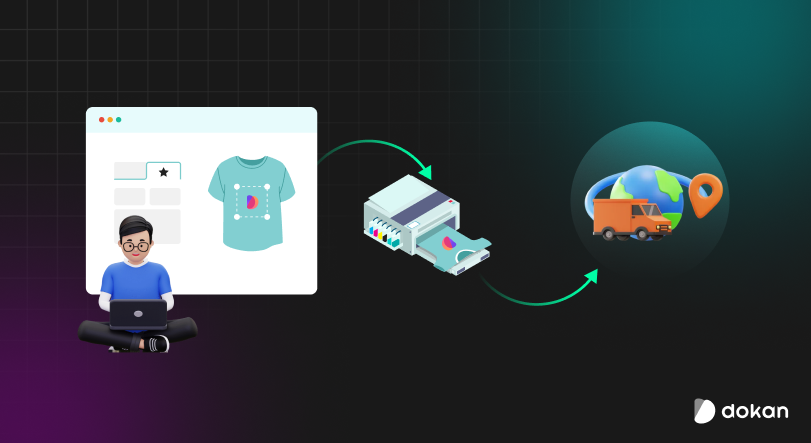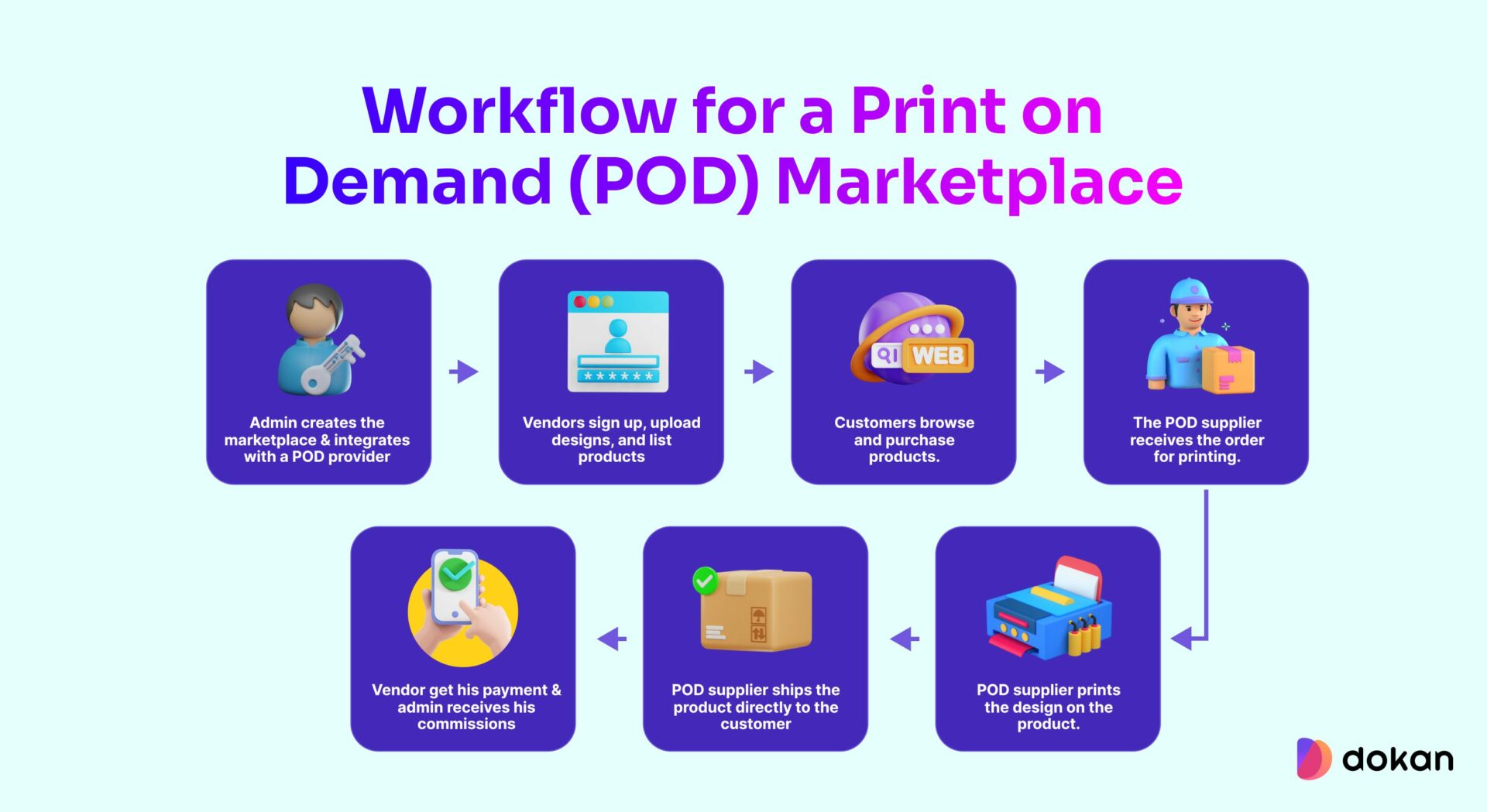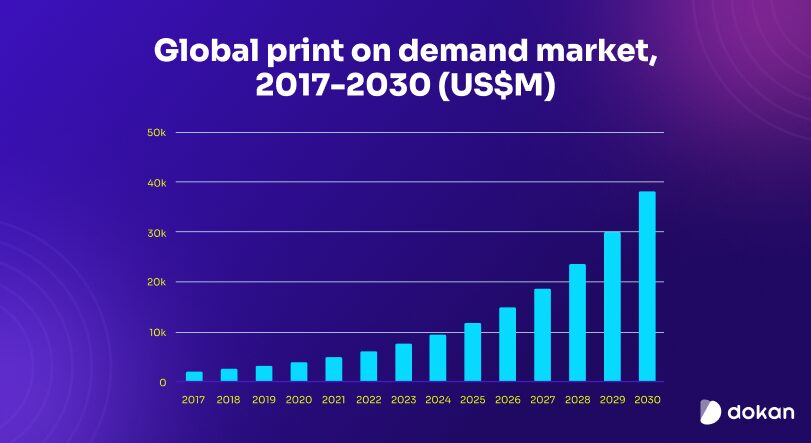Print On Demand Marketplace: Everything You Need to Know
[ad_1]
Are you thinking about launching your own marketplace or selling custom products? Print-on-demand (POD) is a fantastic way to do it. Especially if you don’t want to deal with the hassles of inventory, packaging, and shipping.
With the rise of digital platforms and customized shopping experiences, POD marketplaces have become a popular choice for entrepreneurs and artists.
In a POD marketplace, the platform owner creates the space, but it’s the vendors (or sellers) who design and sell custom products like t-shirts, mugs, or phone cases.
The best part? Vendors only pay for products when customers order them, and the marketplace doesn’t need to store or manage inventory.
In this guide, we’ll walk you through the essentials of starting a POD marketplace, from its unique benefits to the challenges you might encounter along the way.
What is a Print-on-Demand Marketplace?
To understand what a POD marketplace is, you need to understand 3 things:
- What is Print on Demand
- What is a Marketplace, and
- What is Print on Demand Marketplace
Let’s explore all of them!
1. What is Print on Demand (POD)?


Print on demand is a business model where products are printed only when someone orders them.
Instead of buying large quantities of products ahead of time and storing them, you only create the product after a customer orders it. This means you don’t have to worry about inventory or upfront costs.
For example, if you’re a designer, you can create a custom t-shirt, list it on your platform, and when a customer places an order, the t-shirt is printed and shipped directly to them. No need to worry about managing stock or fulfilling orders yourself. The POD provider takes care of all that!
2. What is a Marketplace?
A marketplace is an online platform where buyers and sellers come together. Think of it like a virtual mall, where multiple vendors can list their products, and customers can browse and make purchases.
Some popular marketplaces are Etsy, Amazon, and eBay. As the admin of the marketplace, you provide the platform, handle payment processing, and might even do some marketing. The vendors (sellers) focus on creating and selling their custom products, but you make the space for it all to happen.


3. What is a Print on Demand Marketplace?
A Print on Demand Marketplace is a platform where sellers upload their designs. When customers make a purchase, the platform works with a Print on Demand provider to print and ship the product directly to the customer. The seller need not worry about production, storage, or shipping.
As the admin of the marketplace, you create the space for these vendors to sell their products, and you manage the overall platform. You don’t have to print or ship anything yourself. Instead, you partner with POD providers who handle the production and delivery.
A Simple Demonstration of Print on Demand Marketplace


Let’s say you launch your own POD marketplace called “CustomGear”. You create a platform where artists and designers can upload their artwork and sell it on various products like t-shirts, mugs, phone cases, and more.
Here’s how it works:
- Sellers Upload Designs: Vendors (the sellers) upload their designs to your platform.
- Customers Make Purchases: A customer visits CustomGear. She likes one design and orders a t-shirt.
- POD Provider Handles Fulfillment: Once the order is placed, a Print on Demand provider like Printful or Printify prints the design on the t-shirt and ships it directly to the customer.
- Admin Revenue: You, as the marketplace admin, earn a percentage of the sale for providing the platform and connecting sellers with customers. You don’t need to handle any of the physical products, production, or shipping.
Why is This a Great Model for Marketplace Admins/Owners?
The Print-on-Demand industry has been growing fast. In 2022, the global POD market was valued at approximately $6.18 billion. It is expected to grow to $38.21 billion by 2030. This represents an impressive growth rate of nearly 26% per year.


North America leads the way, making up over 35% of the global POD market in 2022.
You can also be a part of this growing industry. Here are some exclusive benefits you’ll enjoy as a POD marketplace admin:
- Low Overhead: Since you don’t have to manage inventory or production, your upfront costs are much lower compared to traditional eCommerce models.
- Scalability: You can grow your marketplace as big as you want without worrying about the logistics of manufacturing or storing products.
- More Product Variety: Since vendors are responsible for uploading their own designs, you can offer a wide variety of products without having to source or create them yourself.
- Focus on What You Do Best: You can focus on creating a great user experience, marketing, and growing your marketplace, while the POD providers take care of production and fulfillment.
- Global Reach: Many POD providers offer worldwide shipping, which means you can serve customers anywhere, with no extra effort on your part.
In short, a Print on Demand Marketplace lets you create a platform for vendors to sell custom products—without the hassle of managing inventory, shipping, or fulfillment. It’s a low-risk, scalable business model that puts the focus on creating a great marketplace experience while others handle the rest.
Next up, we’ll take a deeper dive into how to build your own successful POD marketplace and what you need to consider before launching!


Things You Need to Consider Before Starting a POD Marketplace
Starting a Print on Demand (POD) marketplace sounds like a great idea, but before you dive in, there are some important things to think about.
Setting up a successful marketplace takes careful planning and a solid strategy. Let’s go over the important things you should think about before getting started.
- Find the Right Niche for Your Marketplace
- Partner with a Reliable POD Provider
- Picking a Dynamic Platform to Setup Your Business
- Set Your Pricing and Commission Model
- Onboard Right Sellers for Your Online Store
- Handle the Legal Stuff for Your Marketplace
- Prioritize Customer Experience to Build Trust & Loyalty
1. Find Your Niche – Don’t Be Afraid to Specialize
The first step in building a successful marketplace is figuring out what you’re going to sell. Are you going to offer a broad range of products like t-shirts, mugs, and phone cases? Or are you going to specialize in something unique, like eco-friendly merchandise or custom pet products?
Having a niche helps you stand out and attract the right sellers and buyers. It also makes marketing and growing your platform easier.
2. Partner with the Right POD Provider – They’re Your Production Partner
You’re not going to be printing and shipping the products yourself. You need to find a reliable POD provider to handle that side of the business. The quality of your POD provider can make or break your marketplace, so do your research! Look for a provider that offers:
- A variety of products your sellers will want to offer
- Fast and affordable shipping
- Great print quality
- Easy integration with your platform
Popular providers include Printful, Printify, and Gooten. Pick the one that best fits the needs of your marketplace and customers.
3. Picking the Right Platform – Your Marketplace’s Home Base
Next, you’ll need a solid platform to host your marketplace. There are two different ways to do that.
- Go for a marketplace builder like Dokan to create your multi-vendor setups.
- Or, if you have the budget and the know-how, build a custom website that meets your specific needs.
Make sure the platform you choose is easy for both vendors and customers to use. It should support product listings, secure payments, and seamless order management.
Your platform is the backbone of your marketplace, so choose wisely!
Important Note: Dokan is the only marketplace solution that offers Print on Demand features. With the premium Printful module, marketplace owners can enable their vendors to sell custom products without inventory or upfront costs.
4. Set Your Pricing and Commission Model – Keep It Simple but Fair
When it comes to pricing, you need to balance affordability for customers with profitability for your marketplace. Decide:
- What you’ll charge customers for each product (consider POD provider costs, shipping, and any platform fees).
- How much commission you’ll take from each sale? This could be a flat percentage (say, 20%) or a tiered system based on the product price.
The key is to keep things transparent and fair for vendors while ensuring your marketplace makes a profit.
A quick tip: Choose a marketplace solution that allows you to set different commission types for your store.
5. Onboard Your Sellers – Keep It Smooth and Supportive
Your marketplace will grow with talented vendors. Plan how to onboard new sellers and give them the tools and support they need to succeed. This might include:
- A clear sign-up process and easy-to-follow guidelines for uploading designs.
- Support for vendors in case they run into any technical issues.
- Marketing resources or tips to help them promote their products.
Your goal should be to make it as easy as possible for vendors to get started and succeed on your platform.


Subscribe to
Dokan blog
6. Handle the Legal Stuff – Better Safe Than Sorry
No one likes to think about the legal side of things, but it’s essential to get it right. Make sure you cover:
- Terms of service: Clear rules for how your marketplace works, covering both vendors and customers.
- Intellectual property: Guidelines for vendors to avoid copyright issues, especially if they’re using images or designs that aren’t their own.
- Payment processing and taxes: Set up systems for handling payments, commissions, and taxes. This might require consulting a tax professional or lawyer.
Getting the legal stuff sorted from the beginning will save you headaches down the road.
7. Marketing Your Marketplace – Get the Word Out
Once your marketplace is live, it’s time to get the word out! You’ll need a solid marketing strategy to attract both vendors and customers. Here are a few things to consider:
- Vendor recruitment: Use social media, ads, and networking to bring talented sellers to your platform.
- Customer acquisition: Invest in SEO, social media marketing, and even influencer partnerships to drive traffic to your marketplace.
- Content marketing: Consider starting a blog, running email campaigns, or creating other content to engage your audience and build your brand.
Marketing is a long-term game, so start building awareness early on.
8. Prioritize Customer Experience – Build Trust and Loyalty
A great customer experience is crucial for the success of your marketplace. Focus on:
- Easy navigation: Make sure it’s simple for customers to browse and find products they love.
- Trust: Display customer reviews, product ratings, and clear shipping info to give customers confidence in their purchases.
- Responsive customer service: Handle inquiries, complaints, and returns quickly and professionally.
When customers have a positive experience, they’ll be more likely to return—and recommend your marketplace to others!
Starting a POD marketplace takes a bit of time and effort, but with the right planning, it can be a very rewarding business model.
As promised, let’s now dive deeper into how to choose the perfect platform for your POD marketplace. ⤵️
How to Select the Best Platform for Your POD Marketplace
If you’re not a tech expert, building a custom platform from scratch can be overwhelming. Thankfully, you don’t need to worry about that.
Choosing a ready-made POD marketplace platform is the smartest way to go! It saves you a ton of time, effort, and money.
These platforms are designed to handle all the complex technical stuff for you. This allows you to focus on what matters most—growing your marketplace.
But all the platforms may not be a good fit for your business. Here’s what you need to look for in the right POD marketplace platform:
Key Features Your POD Marketplace Platform Needs:
- POD Supplier Integration: Your platform should easily connect to top POD suppliers (like Printful, Printify, or Gooten). This automatically prints and ships orders, so you don’t need to manage any inventory.
- Multi-Vendor Support: Since you’re running a marketplace, you need a platform that allows multiple sellers to list their products and manage their own inventory, while you handle the overall marketplace.
- Automated Order Fulfillment: Look for a platform that automatically sends orders to your POD supplier once a customer purchases something. This keeps everything running smoothly and saves you time.
- Customizable Product Pages: Your vendors should be able to easily create and customize product listings. The platform should make it simple for them to upload designs and set prices without any hassle.
- Payment Handling: The platform should handle payments smoothly for you and your sellers, from customer orders to vendor payouts.
Focus on a platform that connects with POD suppliers, supports multiple vendors, and automates the fulfillment process. This will make it much easier to manage your marketplace and grow your business.
One such platform is Dokan. It’s the only marketplace solution that offers a seamless Print on Demand feature through the Dokan Printful module. So, your vendors can easily integrate directly with leading POD suppliers.


Attracting Sellers and Building a Community
Once your Print on Demand (POD) marketplace is up and running, your next goal is to attract talented sellers and create a strong community around your platform.
As we’ve already discussed, getting the right vendors for your marketplace is crucial. But once you’ve attracted them, it’s all about building a community where they feel supported, engaged, and excited to stay.
Here’s how to do both—get great sellers and create a space they’ll love.
1. Use Local Trends to Attract the Right Sellers
Local trends are a great way to attract sellers who can offer products that resonate with your audience. Think about what’s popular in your area, or what people are passionate about right now.
- Eco-friendly products: Many people across the U.S. are becoming more environmentally conscious. Sellers offering eco-friendly items like reusable water bottles, biodegradable phone cases, or organic cotton t-shirts are in demand. For example, brands like Hydro Flask and Everlane have built strong followings by emphasizing sustainability.
- Seasonal goods: People love holiday-themed or seasonal products. Sellers offering items for events like Thanksgiving, Independence Day, or Halloween often see spikes in sales. For example, custom Thanksgiving-themed shirts or Fourth of July t-shirts that celebrate U.S. pride are great seasonal products.
- Local pride: Many people love showing off their hometowns or local sports teams. Encourage sellers to offer items like state-themed mugs, college football gear, or designs featuring iconic landmarks (such as the Statue of Liberty or the Grand Canyon).
Editor’s Tip: Promote these trends through your marketing. Use holidays or local pride to help your vendors stand out and attract buyers. Think of how products tied to the Super Bowl, Memorial Day, or Black Friday can resonate with your audience.
2. Build a Relationship with Your Sellers
Once you know the trends, it’s time to bring the right sellers to your marketplace. You want vendors who are passionate and excited about what they’re selling.
- Regional pride: Sellers who focus on specific areas, like cities or states, can tap into local pride. For example, custom apparel or souvenirs for states like Texas, California, or New York will attract loyal customers. Think about California love shirts or New York City skyline prints—products that speak to local pride.
- Hobbies and interests: Think about what people love doing in their free time. Outdoor gear for hiking, fishing, or camping is always a hit in areas like the Pacific Northwest or Colorado, where outdoor activities are a big part of the lifestyle. Sellers offering custom camping mugs, personalized hiking shirts, or portable gear can tap into these markets.
- Fan gear: Whether it’s supporting local school teams or cheering for national leagues, sports-related products are always in demand. Custom jerseys, hats, and accessories for teams like the Dallas Cowboys, New York Yankees, or Los Angeles Lakers can attract buyers. College sports are also huge—think of selling University of Michigan or University of Texas merchandise.
Editor’s Tip: Target niche groups through social media, events, or online communities. This will help you find sellers who are passionate about these specific interests.


Subscribe to
Dokan blog
3. Offer Tools and Support for Sellers to Succeed
Attracting great sellers is only part of the equation. Once they’re on board, make sure your marketplace provides the tools they need to succeed.
- Marketing support: Help your sellers promote their products with seasonal campaigns, guides, and tips for marketing their designs. For example, you could help sellers get noticed during Black Friday sales or create campaigns around Mother’s Day or Father’s Day.
- Easy payments: Offer a simple, secure payment system that supports popular methods like PayPal, Venmo, or Apple Pay. These payment systems are widely used in the U.S. and make transactions easier for both sellers and buyers.
- Reliable shipping: Partner with reliable shipping providers like USPS, UPS, or FedEx to ensure products are delivered quickly and affordably.
Editor’s Tip: Give sellers the tools they need to succeed. Make it easy for them to market their products, accept payments, and ship orders. If you support fast and affordable shipping, it will help you stand out in a competitive market.
4. Build a Supportive Community for Your Sellers
Once your sellers are onboard, it’s time to create a space where they feel supported. Building a community will help keep them engaged and encourage long-term loyalty.
- Host learning sessions: Organize online workshops or webinars where your sellers can learn tips on growing their business. Focus on things like product photography, marketing, and customer service. For example, you could host a session on how to create designs for holiday seasons like Christmas, Easter, or Valentine’s Day—all of which are huge shopping events in the U.S.
- Spotlight your top sellers: Highlight your best-performing vendors in your blog or on social media. A “Vendor of the Month” spotlight or a social media post showcasing top sellers can give them exposure and motivate others to do their best.
- Create a space for collaboration: Set up a group or forum where sellers can share tips, ask questions, and support each other. This helps build trust and encourages vendors to stay engaged.
Editor’s Tip: When you create a supportive community, your sellers will feel more connected and motivated to keep selling on your platform. A Facebook group, Slack channel, or even regular virtual meetups can help promote a sense of belonging.
5. Partner with Local Influencers
Influencers can help spread the word and bring new sellers and buyers to your marketplace. Find influencers who align with your niche and have a loyal following.
- Influencer partnerships: Work with influencers who share your audience’s interests—whether it’s eco-friendly influencers, fashion bloggers, or sports fans. For instance, you could partner with an influencer from California promoting beachwear or a New York influencer showcasing local streetwear brands.
- Collaborate on exclusive products: Partner with influencers to create special, limited-edition products. A custom product line tied to the NBA Finals or a special-edition Christmas hoodie could generate excitement and draw attention to your marketplace.
Editor’s Tip: Focus on influencers who already connect with your target audience. Their recommendations will feel more authentic and can drive new traffic to your marketplace.


Challenges You May Face and How to Overcome Them
Creating a Print on Demand marketplace is an exciting venture, but it’s not without its challenges. From attracting the right sellers to building a supportive community, you’ll face obstacles along the way.
But don’t worry! These hurdles are all part of the process and with the right approach, you can overcome them.
Let’s shine a light on some of the challenges you might encounter and how to tackle them effectively.
- Attracting Traffic to Your Marketplace: New marketplaces can struggle to attract traffic, especially with established competitors. Focus on a niche, build a strong community, and offer unique products to stand out from the crowd. Use SEO, social media marketing, and influencer collaborations to drive traffic.
- Managing Quality Control: Quality can be a challenge since the marketplace owner doesn’t handle production. Choose a reliable POD provider with strong reviews and clear product guidelines to ensure consistent quality and customer satisfaction.
- Handling Customer Service: While you don’t handle fulfillment, you still need to manage customer service issues like order inquiries, returns, and disputes. Set up a solid FAQ section, respond quickly to inquiries, and partner with your POD suppliers for smooth order handling.
- Dealing with Vendor Issues: Managing multiple vendors can be tricky. Establish clear guidelines, set expectations from the start, and maintain open communication. Consider creating vendor training materials to help them succeed on your platform.
- Competing with Larger Marketplaces: Competing with giants like Etsy or Amazon can seem daunting. Differentiate your platform by offering unique products, focusing on niche markets, or providing exceptional customer service that bigger platforms can’t match.
These challenges are all part of the journey. With the right strategies, you’ll be on your way to building a successful POD marketplace.
Here is a step-by-step guide to create a handmade product marketplace like Etsy using Dokan within limited resources.
Build Your Print-on-Demand Marketplace & Make Money Online!
Building a Print on Demand marketplace is a fantastic way to turn your passion into a business. You can skip the hassle of inventory, storage, and upfront costs.
Now that you have a clear roadmap from picking the right platform to attracting talented sellers—you’re ready to make your marketplace a success.
The secret to making it work? Find a niche that excites you, partner with a trusted POD provider, and create an easy, seamless experience for both your sellers and customers.
Ready to launch your first Print on Demand marketplace on WordPress? → Dokan plugin is the ultimate solution to make it happen!
Think about platforms like Etsy or Redbubble. They focus on unique products and building loyal communities. You can do the same!
With the right strategy, you can also create your own space in this growing market and start an eCommerce business with no money.
So, what are you waiting for? It’s time to turn your ideas into action. If you’re ready to start, or have questions, drop a comment below. We’d love to hear your thoughts and see what you’re planning!
Subscribe to
Dokan blog
We send weekly newsletters, no spam for sure!


[ad_2]
منبع:dokan



